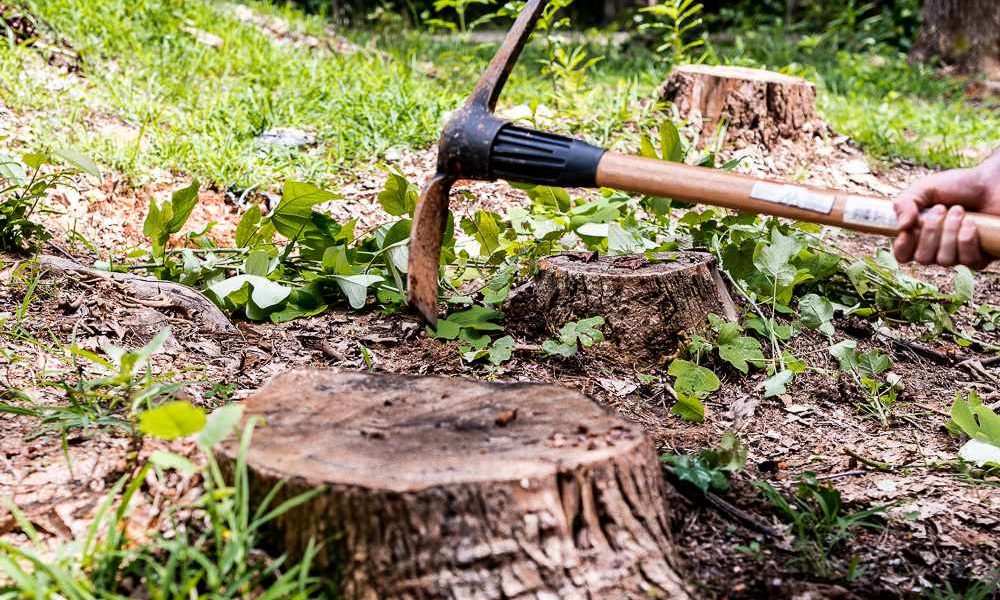Introduction to Stump Removal
Tree stumps often become unintentional fixtures in gardens, representing both aesthetic and practical challenges. Left behind from prior tree removal, these stumps are more than just an eyesore; they can impede landscaping projects, harbor insects, and pose tripping hazards. Understanding the process of stump removal is essential for those looking to clear their land effectively. Given the complexity of root systems and variations in soil type, removing a stump can be daunting. According to Family Handyman, every stump presents unique challenges, making it crucial to consider the best approach tailored to your specific situation.
Necessary Tools and Safety Gear
Embarking on a DIY stump and tree removal project requires a solid collection of tools and protective gear. A chainsaw is indispensable for initial cutting and slicing the stump close to the ground to make it more manageable. For manual removal, hand tools such as a shovel, an ax, and a pick mattock will aid in revealing and severing roots. In more challenging scenarios, renting a stump grinder can be a game-changer, offering efficiency that hand tools cannot. Safety gear is equally important — protective gloves help keep your hands free of splinters and cuts, goggles shield your eyes from flying debris, and steel-toed boots guard your feet against heavy equipment. Don’t forget ear protection, especially when operating loud machinery like a stump grinder. Taking these precautions ensures that you can focus on the task safely and effectively.
Step-by-Step Guide to DIY Stump Removal
Start by clearing the area around the stump to gain unencumbered access. Use a chainsaw to cut the stump as low as possible without going underground, which simplifies the remaining process. Next, use a shovel and pick mattock to dig around and beneath the stump, revealing as many roots as possible. Sever the exposed roots using an ax for manual removal. If the stump remains tenaciously grounded, a stump grinder can handle the task more efficiently. Always read and follow the grinder’s manual to avoid mishaps. This approach, step-by-step, ensures a thorough removal that respects the natural landscape around the former tree.
Eco-Friendly Stump Disposal Methods
For the environmentally conscious, there are several sustainable methods to dispose of stumps without resorting to chemicals. One option is to let nature take its course by layering the stump under mulch and compost, which accelerates decomposition. Alternatively, drilling holes and adding a natural nitrogen source like fertilizer encourages faster rotting. This method is advantageous, as it minimizes chemical run-off and contributes nutrients back to the soil. Guidance on such techniques can be found on the Environmental Protection Agency website, which emphasizes safe gardening practices and eco-friendly waste management.
Signs You Need Professional Help
Despite the best DIY intentions, certain circumstances necessitate professional involvement. Large, stubborn stumps with extensive roots hugging the ground can challenge even the most dedicated amateur. If a stump is dangerously close to your home, underground utilities, or other structures, professional arborists can remove it safely without risking property damage. Weighing the cost of professional services against personal effort, time, and safety risks can often justify seeking expert assistance, particularly for homeowners lacking the necessary experience or equipment.
Common Mistakes to Avoid
Many stumble upon the same pitfalls when undertaking stump removal. A common oversight is neglecting proper tool maintenance and usage, such as using a dull chainsaw, which can complicate and elongate the process. Another mistake is underestimating the physical demands of digging around deep-rooted stumps, which can lead to fatigue or injury. Failing to consider stump and tree species differences also causes unnecessary complications, as some woods decompose more slowly than others, requiring different approaches. Avoid these missteps by embracing thorough preparation and awareness as key components of your stump-removal strategy.
FAQ on Stump Removal
- How long does it take to remove a stump? It varies. Manually, it can take several hours to a full day, while a stump grinder could cut this time to under an hour for small-to-medium stumps.
- What is the cost of stump removal? DIY costs mainly involve tool rental, which can be relatively low, whereas professional services may cost between $100 and $500 per stump, depending on size and difficulty.
- Are there any risks involved? Yes, the improper use of tools can lead to injuries. Always wear appropriate safety gear to mitigate these risks.
Final Thoughts
Successfully removing a tree stump from your yard not only enhances its appearance but also paves the way for new landscape projects. While DIY methods certainly empower homeowners with a gratifying sense of accomplishment, the expertise of professionals should not be underestimated when situations exceed your comfort zone. By thoroughly preparing, respecting the complexity of first-time removal, and ensuring the task is performed safely, clearing a stump can be a stepping stone to revitalizing your outdoor environment.

